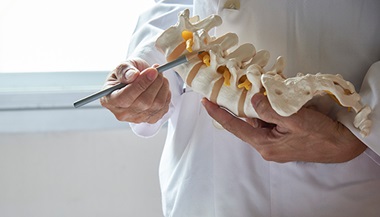Spinal Cord Stimulator Removal: Q&A with a Neurosurgeon
Featured Expert:
While some people with chronic pain enjoy enormous benefit from spinal cord stimulation, these devices don't work out for everyone. Neurosurgeon William S. Anderson, who specializes in functional neurosurgery including neuromodulation techniques, discusses why some patients choose later to reverse the procedure.
What is spinal cord stimulator removal?
Spinal cord stimulator removal is a surgical procedure to take out a spinal cord stimulator, a device that was originally implanted above the spinal cord to manage chronic pain.
Why are spinal cord stimulators removed?
“The most common reason for spinal cord stimulator removal is inadequate pain relief,” says Anderson. As a rule of thumb, surgeons aim for at least a 50% reduction in pain when initially implanting a spinal cord stimulator, but there’s no objective way to gauge pain levels. “We typically let patients decide whether they keep their device or not; most live with the stimulator for two to three years before considering removal.”
What could go wrong with a spinal cord stimulator, and how can you tell?
A spinal cord stimulator, although a safe and tested device, may experience issues after being implanted for several years. This can happen for many reasons, including mechanical failures, infections and general lack of efficacy.
Other than not providing sufficient pain relief, a spinal cord stimulator could lead to problems that may require additional procedures to maintain or reposition the device. These issues may include:
Lead Migration
If the leads (the implants) move, the tingling sensation caused by your stimulator (often called paresthesias) will shift to a different part of the body. This often reduces your device’s ability to control your pain, so it will feel more severe.
Device Damage
If the lead or pulse generator (battery pack) breaks — after a fall or other trauma or just normal wear and tear — the paresthesias will cease completely, and you will no longer have any pain relief from your stimulator.
In rare cases, the device can malfunction, causing pain or a sudden jolting sensation.
Infection
Infection around a spinal cord stimulator can cause swelling, redness, pain or discharge in that specific area or more general symptoms like fever or delirium. Infections are more common near the battery pack than in the leads.
Let your doctor know if you experience any problems with your device. Modern spinal cord stimulators can send diagnostic information wirelessly, allowing your surgeon to identify mechanical and electrical issues remotely.
How is a spinal cord stimulator removed?
Spinal cord stimulator removal surgery varies depending on the type of lead your device uses. Spinal cord stimulators are composed of two parts: the battery, which powers the device, and the leads, which deliver the stimulation.
There are two categories of leads: percutaneous and paddle. Percutaneous leads are inserted into the spine with an epidural needle and are smaller and easier to remove. Paddle leads, by contrast, are larger and usually anchored to the spinal column under a small piece of bone during a laminectomy procedure. They are still removable, but the procedure is more involved.
“Removing these leads, especially the larger ones, is not a trivial procedure. It’s best done by a surgeon with significant experience in this area,” advises Anderson. You may expect to spend a night in the hospital after a paddle lead removal.
Spinal Cord Stimulator Removal: Percutaneous Leads
To remove a spinal cord stimulator with percutaneous leads, the surgeon will make a small vertical incision along the back, exposing a portion of the spinal column where the leads sit. Percutaneous leads are usually held in place with plastic anchors, which your surgeon will locate to carefully extract the device from the epidural space, a delicate area between the vertebrae and the spinal cord.
Once the leads are out, your surgeon will make another incision to remove the implantable pulse generator, which is typically located in the lower back or buttocks.
When the two components have been disconnected and removed, the surgeon closes the incisions, and the procedure is complete.
The surgery takes about an hour and is typically performed while you are under general anesthesia. Depending on your health, your surgeon may recommend lighter local anesthesia instead.
Spinal Cord Stimulator Removal: Paddle Leads
To remove a spinal cord stimulator that uses paddle leads, surgeons make an incision along the back above a patient’s device. This incision exposes the scar capsule that was created when the leads were initially implanted.
The surgeon opens that capsule to carefully detach the leads without disturbing the spinal cord. When the leads are out, the surgeon disconnects the device and removes all of the cabling. This may require drilling a small window in the bone above the spinal cord.
Then, the surgeon makes a second incision near the lower back or buttock to remove the device battery.
The procedure takes about 2 1/2 hours and is performed under general anesthesia.
Spinal Cord Stimulator Removal Recovery
Recovery from spinal cord stimulator removal is fairly quick. Most patients spend one night in the hospital for monitoring and return home the next day.
Surgical pain subsides faster in patients who have had percutaneous leads removed (after about a day) than in patients who had paddle leads taken out (around a week).
“For the most part, I let patients play it by ear. They can return to work and physical activity as soon as they’re feeling better but will need to avoid lifting anything over 20 pounds for about three weeks,” says Anderson.
Spinal Cord Stimulator Removal Complications
Complications of spinal cord stimulator removal are rare, occurring in only 2–3% of procedures. Surgeons carefully screen patients to minimize the risk of these complications. They include infection and cerebrospinal fluid (CSF) leak.
- Any surgical procedure, including spinal cord stimulator removal, carries the risk of infection. Before you leave the hospital, your care team will provide instructions to keep your incisions clean to avoid infection.
- CSF leaks can occur when the surgeon opens the scar capsule that forms around the larger paddle leads. Manipulating this delicate area can tear a small hole in the dura, the outermost layer of the spinal cord, allowing some of the fluid to leak out. This complication is not usually life-threatening but often requires an additional surgery to repair.
Pain Management After Spinal Cord Stimulator Removal
Patients whose stimulators have been removed will need to pursue other therapies to manage their chronic pain. These therapies may include:
- Cognitive behavioral therapy (CBT): CBT is a form of psychotherapy that teaches patients ways to cope with a variety of conditions, including chronic pain.
- Medications: Doctors are investigating more effective, less addictive medications for chronic pain. Two types of medications have shown promise:
- Antidepressants: These drugs treat depression by changing how the nerve cells communicate with one another. This same mechanism can alter how the body transmits pain messages.
- Antiepileptics: These medications are primarily used to prevent seizures but can also help calm faulty pain networks that are sending incorrect







